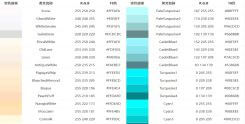- 欢迎使用千万蜘蛛池,网站外链优化,蜘蛛池引蜘蛛快速提高网站收录,收藏快捷键 CTRL + D
怎么优化抖音商品名称呢(如何优化360推广)
怎么优化抖音商品名称呢
1. 确定关键词:
- 品牌名称
- 产品特点
- 用户需求
2. 把关键词写到名称里
3. 注意名称长度,不要超过15个字
如何优化360推广
1. 确定关键词:
- 产品特点
- 用户需求
- 地域、场景等特殊因素
2. 准确设置推广地域和投放人群
3. 制定出合理的竞价策略,并且进行调整
4. 准备好吸引用户点击的落地页,并且加入跟踪代码去跟踪转化率
如何使用竞争情报来改善我的SEO优化策略
1. 确定竞争对手
2. 收集竞争对手的关键词
3. 对比竞争对手的网站结构,包括页面标题、Meta描述、URL、H1标签等
4. 比较竞争对手的SEO关键词排名,找出他们的优势和劣势,然后优化我们自己的关键词排名
5. 比较竞争对手的网站内容,包括文字、图片、视频等,然后提升我们自己的网站内容质量
6. 根据竞争对手的链接数量和质量,执行外部和内部链接建设的策略,加强我们自己的链接的质量和数量

如何使用元标签来优化我的网站
meta charset:指定网页的字符集编码
meta name="description":设置网页的描述信息
meta name="keywords":设置网页的关键词
meta name="author":设置网页的作者
meta http-equiv="refresh":设置网页的定时刷新
meta name="viewport":优化网站在移动设备上的显示效果
meta name="robots":控制搜索引擎是否抓取和索引网页
如何使用结构化数据来增强我的网站在搜索结果中的可见性
1. 通过schema.org找到与网站内容相关的结构化数据类型
2. 在网站的HTML标记中添加结构化数据。下面是一些常见的结构化数据标记示例:
Organization(组织)
<script type="application/ld+json">
{
"@context": "https://schema.org",
"@type": "Organization",
"url": "https://www.example.com",
"name": "Example",
"contactPoint": {
"@type": "ContactPoint",
"email": "contact@example.com",
"telephone": "+1-888-555-1212",
"contactType": "Customer service"
}
}
</script>
BreadcrumbList(面包屑导航)
<script type="application/ld+json">
{
"@context": "https://schema.org",
"@type": "BreadcrumbList",
"itemListElement": [
{
"@type": "ListItem",
"position": 1,
"name": "Home",
"item": "https://example.com"
},
{
"@type": "ListItem",
"position": 2,
"name": "Products",
"item": "https://example.com/products"
},
{
"@type": "ListItem",
"position": 3,
"name": "Books",
"item": "https://example.com/products/books"
}
]
}
</script>
Product(产品)
<script type="application/ld+json">
{
"@context": "https://schema.org/",
"@type": "Product",
"name": "Example Product",
"image": "https://www.example.com/foo.jpg",
"description": "A product that does amazing things.",
"brand": {
"@type": "Thing",
"name": "Example Brand"
},
"offers": {
"@type": "Offer",
"url": "https://www.example.com/product/123",
"priceCurrency": "USD",
"price": "100.00",
"priceValidUntil": "2022-12-31",
"availability": "https://schema.org/InStock",
"seller": {
"@type": "Organization",
"name": "Example Seller"
}
}
}
</script>
如何创建高质量的内容,并使其在搜索引擎中排名更高
1. 确定目标受众: 开始前,要明确目标受众群体的需求和兴趣点。
2. 研究关键词: 使用工具来找到有趣的话题,并为目标受众优化关键词。
3. 编写有趣的标题: 标题应该精简、准确、具体,并且打破平庸。
4. 创造大量有价值的内容: 内容要有实际价值,需要深度,并且能够满足目标受众的需求和兴趣点。
5. 制作富媒体: 使用图片、视频等富媒体来增强内容的可读性和可视性,吸引用户的目光和提高用户的留存率。
6. 使用内部链接和外部链接: 使用内部链接来提高网站的导航结构和链接权重;使用外部链接来提高网站的可信度和SEO权重。
7. 定期更新: 更新内容以保持与目标受众的需求和兴趣点的同步,以及保持网站活跃度,并且增加更多被搜索引擎收录的机会。





